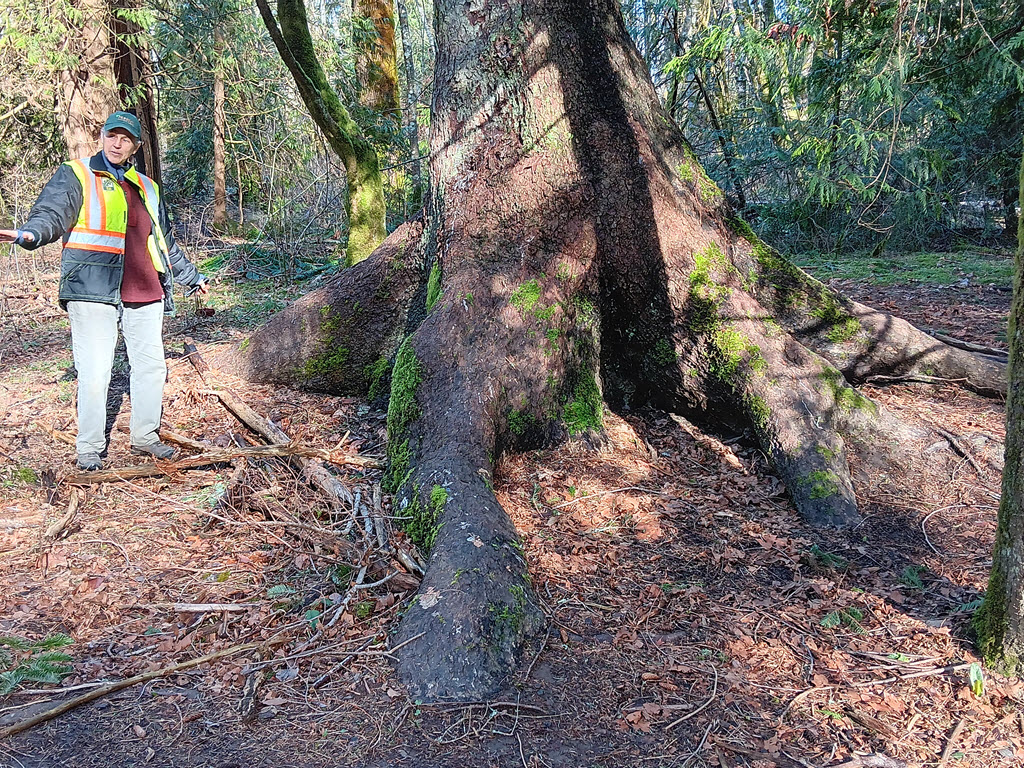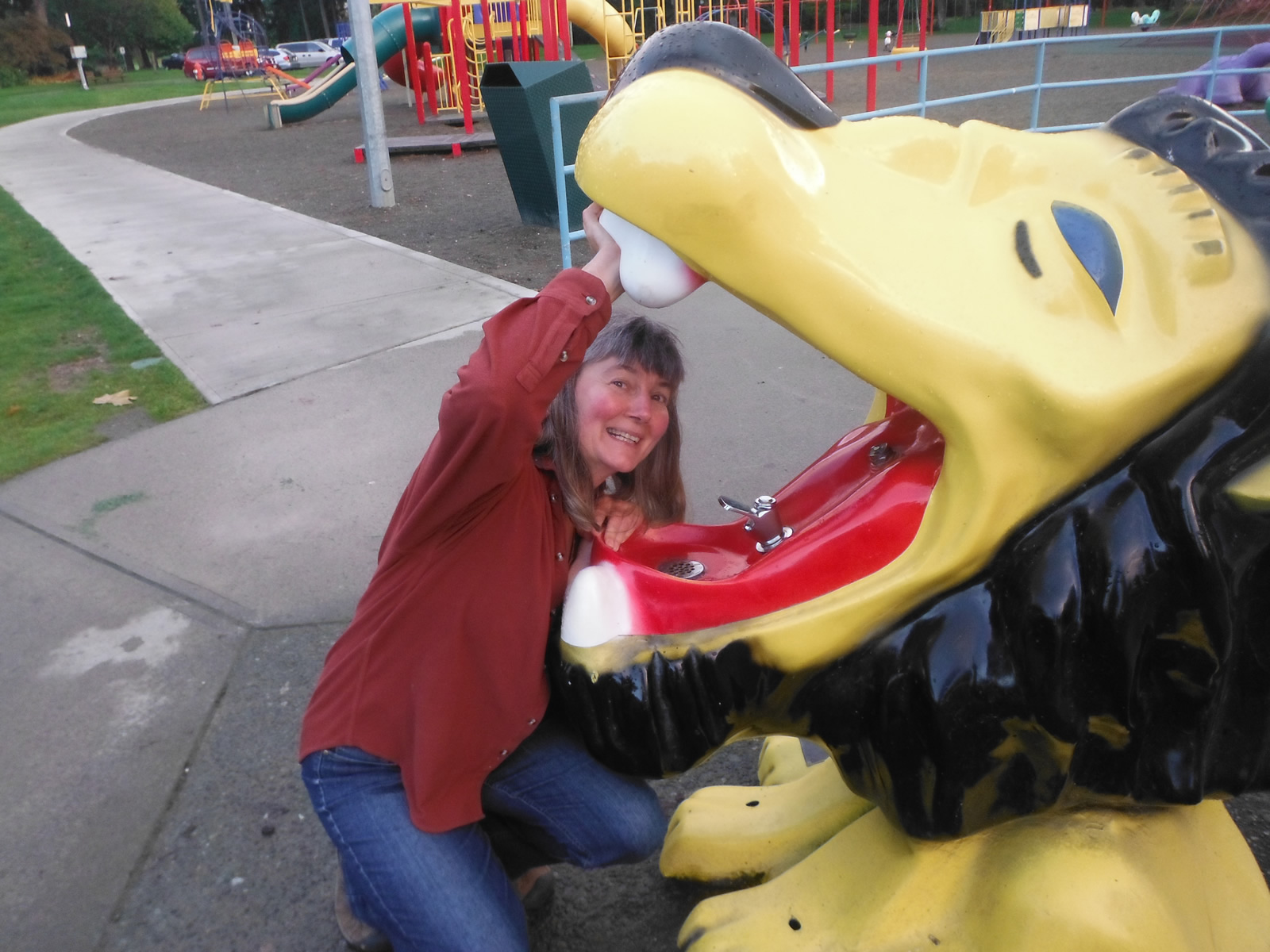In 2024, Comox Valley Naturalists made some significant changes to their popular “Tree of the Year” event. The goal of this annual event (since it began in 2018) has been to identify and highlight trees of significant interest or importance in the Comox Valley to encourage interest in valuing and protecting trees within Comox Valley Regional District. In the past, the emphasis was on encouraging people to nominate trees and then choosing a “winning tree” through a public vote.
In 2024, the emphasis has shifted to helping people value, and visit (or see) all the nominated trees. Check out their “Trees of the Year” blog post to see photos of nominated trees and an explanation of the process and ways you can learn more about the trees. To make it easier for people to view nominated trees or to find special trees of their own, CVN volunteers developed downloadable walking or cycling maps – learn more by visiting the Tour the Trees of the Year 2024.

CVN volunteers also organized several guided walks in the spring. We showed up for the first one on a cool, damp March day at the Comox Valley Exhibition Grounds nature park area, a 2 km trail that meanders through mature coniferous and deciduous trees and native vegetation near the Tsolum River. Organized and introduced by club member Angela Dawson, the walk-and-talk was led by Verna Mumby, (The Tree Lady). Verna turned out to be one of the most knowledgeable, thoughtful tree people I’ve ever heard speak.
Verna began the walk by explaining some of the complexities of the rich ecosystem around us, pointing out native conifers – many grand firs, some Sitka spruce, groupings of black cottonwood in wetter areas. Due to the way this area has been managed, there are still some tall old-growth trees remaining – some are over 30 metres in height.
She contrasted the way she views the forest (landscape perspectives) with the way a forester (like her brother) might view it (commercial) or a city planner or Hydro worker might view it (ease of development or safety). She also reminded us of the impact of our need for order and tidiness (e.g., removing leaves and branches and, in the past, moss from the trees!) and the impact that can have on the conservation of forest ecosystems. She mentioned the black cottonwood that spreads its fluffy seeds throughout the community each year. During COVID-19, people wanted to cut down some of the centrally located trees because they claimed that the seeds and fluff made it impossible to enjoy the outdoors. Yet cottonwoods provide enormous “landscape” value as they filter and hold water in an area and provide protection for many animal and insect species.
Luckily for us, the group was limited to 14 people so we were able to ask questions and take time to listen as Verna pointed out the surprising (to me) number of old growth fir, cedar and Sitka spruce trees. The Comox Valley was heavily logged between the 1860s and 1960s to allow farming and other ventures and few of the really big, valuable trees remain. She walked us towards a group of towering trees and challenged us to identify the one with the large-scaled bark. It turned out to be a Sitka spruce, probably over 150 years old (Sitka spruce are currently blue-listed) . Sitka spruce is one of the largest tree species and was used for many purposes by the local First Nations.
One of the participants asked about the distinctive “feet” that form around many cedars and that we noticed around the tall Sitka spruce. She explained that trees that experience consistent strain from wind and storms in a particular directon will develop “buttress roots” that help to prevent the tree from falling over. She also described the resilience of tall trees and branches as they flex in specific patterns to dissipate the energy of high winds without breaking.
We talked about safety and trees. Many people are afraid of old, tall trees – afraid that they will cause damage or injury as branches fall or a tree is uprooted in a storm. The increased risk of wildfires due to climate change and other factors has many people concerned about dead, standing cedars or forests that have dry understorey vegetation. New government guidelines are recommending people remove coniferous trees and any woody debris from areas surrounding a home to minimize the chance that wind-blown sparks or ground fires could start house fires.
Vera has served as an expert witness in tree assessments and her thoughtful analysis weighs many factors when determining whether a tree should be removed or modified. In cases where the tree needs to be cut, she tries to find ways to leave the main stem or trunk (if it is sound) and in-ground roots to provide potential bird and insect habitat and to preserve the network of roots that live on as part of the “inter-fungal network” of a forest. When focusing on fire risk mitigation, she examines the overall health of the tree and the size and moisture content of the mulch or woody material on the ground. Fine materials are more likely to ignite easily and can be modified, dampened or removed. She tries to maintain a balance between removing flammable materials while recognizing the value of decaying tree stumps and branches.
As our guided walk came to an end, people continued talking and asking questions until Angela called a halt and thanked Vera for leading us on such an interesting and informative forest exploration. We all joined in thanking her (and asking still more questions, and then wandered off to enjoy the rest of the sunshine.
Comox Valley Naturalists: Trees of the Year https://comoxvalleynaturalist.bc.ca/trees-of-the-year-2024/
and Tour the Trees of the Year https://comoxvalleynaturalist.bc.ca/tour-trees-of-the-year-2024/
Tree Lady (Verna Mumby) website – https://www.treelady.ca/index.html
May 26, 2020, Comox Valley Record, Letter to editor – The cottonwood trees in Courtenay are a menace https://www.comoxvalleyrecord.com/opinion/letter-the-cottonwood-trees-in-courtenay-are-a-menace-1608189
More about the history of the Comox Exhibition lands https://www.historicplaces.ca/en/rep-reg/place-lieu.aspx?id=14481
